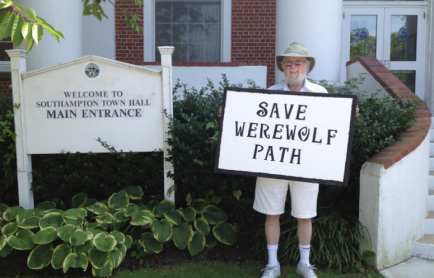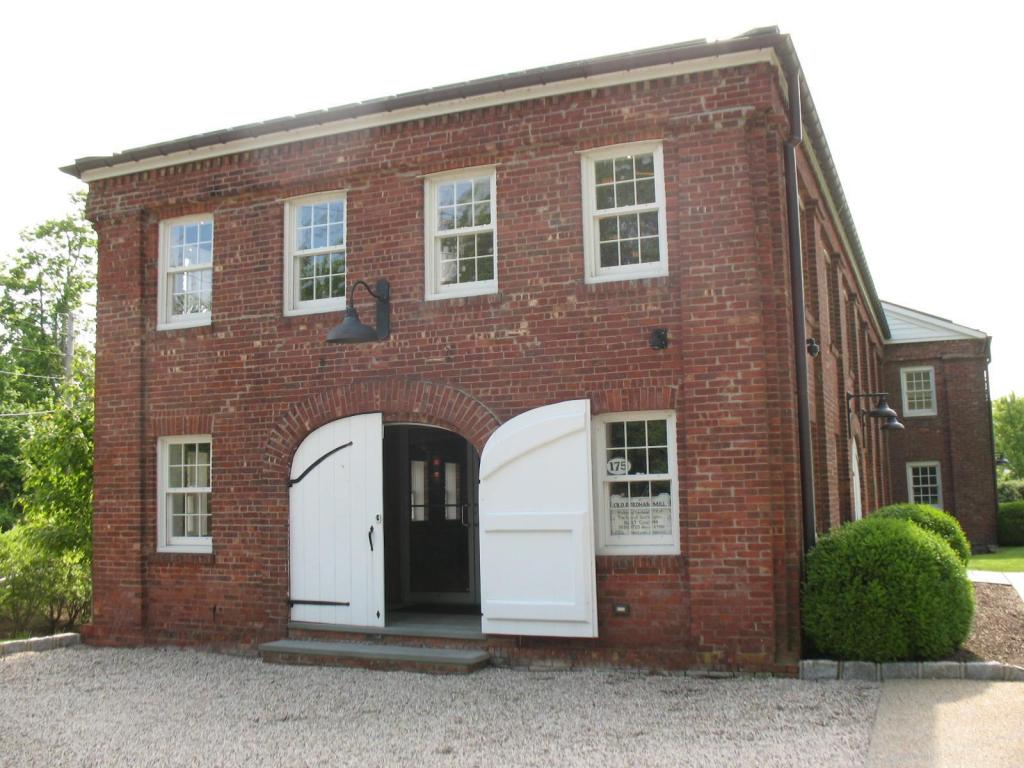Save Werewolf Path: Southampton Trustees Plan to Officially Un-Name This Road August 20

Next Monday afternoon, August 20, the Southampton Town Trustees are going to vote on a resolution to erase the name of a road by the name of Werewolf Path in Noyac. I was heavily involved in the naming of this road. (Uh, I named it.) It’s on all the maps. It’s on my iPhone. It’s on Google. But now, the Trustees intend to do away with it. They WILL do away with it. But I intend to be up there on the front steps of Town Hall picketing and marching to prevent this from happening. I feel bad they no longer want the name I gave it. If you want to help, come up and march with me. Signs should read SAVE WEREWOLF PATH. We can have apple cider and reminisce about the good old days and the evil bureaucrats today who just want to get rid of anything that has charm.
Here’s the story.
In the late 1960s, I drew a map of the Hamptons that had on it the names of every road in the Hamptons. It was done longhand, with all the roads on it printed out personally by me in little letters with a pen. It took me three days, referring to other maps to get things right, to draw this map. While drawing it, I found that there were many dotted line dirt roads that were unnamed. I named them with cute and quaint names—Lois Lane, Uncle Ed’s Romp, Lost Cow’s Journey etc. Perhaps one of them would stick and become a real name. Wouldn’t that be something?
When I finished drawing this map, I sold ads around the border to merchants and then printed 20,000 copies and gave them away free to tourists.
The road I named Werewolf Path soon appeared on other roadmaps. No others did. But I was delighted even with just this one. It leads west off Noyac Path a quarter of a mile and then dead ends.
I wrote the story about naming Werewolf Path in my new memoir STILL IN THE HAMPTONS and last Saturday at 11 a.m., after advertising my performance, went up to it to read the chapter aloud to anyone who wanted to hear it. But when I got there, I found a street sign on the corner where Werewolf Path would be that read Old Sag Harbor Road. I read the chapter anyway—it described how I had drawn this map and named this road and life was good and those were the days—but where the heck was Werewolf Path?
Two days later, Monday, I called the Town Building Department and made inquiries about Werewolf Path. Indeed, the highway department inspector knew about it. But he said it was under the jurisdiction and ownership of the Town of Southampton Trustees, who had offices in another part of the building.
And so I then spoke to Trustee Fred Havemeyer. He knew about it too and wanted to know why I called about it. I told him I wondered how it got its name.
“I will have to look into it,” Havemeyer said. “I think it goes way back to the early settlement days. Lots of roads go back to then. We call them legendary roads rather than named roads. But I’d have to look it up.”
An hour later, he called back. He was unable to find the file on Werewolf Path. He would have to dig deeper, perhaps into the early records of the town to see what he could see.
At this point, I felt sorry for Mr. Havemeyer, who is somebody I know and like. I told him he shouldn’t have to go through all that trouble. I then made an absolutely disastrous mistake. I told him that it was me who had named the road, and I told him the whole story about 1969, about the map, the dotted lines, everything.
He said he still wanted to look into it. It was their road. Just because I put that name on the map doesn’t explain how it came to be accepted by the town.
“It’s not necessary,” I said. I was trying to hold him off.
An hour later he called back again to say he had found the answer.
“I called Squires and Holden, the longtime surveyors for the town. I spoke to Bob Smith there and he told me that he spoke to John Holden who is now retired and that he remembered way back then you had just for fun named a lot of roads with your map and one was Werewolf Path. He liked the name, so they started using it on surveys.”
“Good,” I said.
“Well,” Havemeyer said, “I think this now has to be straightened out. So on Monday, August 20, I am going to make a proposal that from now on this road be officially called…”
“Werewolf Path?”
“Old Sag Harbor Road.”
“How did it get to be Old Sag Harbor Road?”
“I’ll have to look into that too.”
“You did tell me that some of these old roads go back to early times and nobody knows how they got their names, so you just use what people call them—their legendary names.”
“That is true.”
“Well isn’t Werewolf Path a legendary name?”
“You named it in 1969. That’s modern times. We landed on the moon in 1969.”
“Oh,” I said. “Well I’m sorry that I mentioned this.”
“Well maybe you shouldn’t have.”
We said our goodbyes. I don’t think that Mr. Havemeyer appreciated what a terrific blow this was to me, having named something and then having the name accepted and then having it officially rescinded. I thought of Shea Stadium, named after a well-respected lawyer on Long Island, now torn down and gone. I thought of Idlewild airport, named after a man named Idlewild, but now renamed Kennedy Airport. Poor Mr. Idlewild, now long forgotten.
And I thought that 200 years from now, the definition of a “legendary” road could mean not only say 1712 but 2012. All of that was in the old days. Who would know the difference?
Here’s the legend of Werewolf Path. Many years ago, a werewolf roamed in the woods between Deerfield Road and Millstone Road. Millstone Road was named after him because he wore a small replica necklace that had a millstone on it. He also killed and ate deer that were in the fields there.
This werewolf stalked the good citizens of that place for many years, but he never killed any of them, just scared them. Hunters came and shot the werewolf, but each time he was shot he fell down dead but then rose again to be bigger and more terrible than he was before. After awhile, his fangs began glowing green.
Finally, in 1712, a woman named Goodwife Conscience came and cast a spell on the werewolf. As a result, he froze to the spot for two months and never moved even an inch because it was wintertime and the ice was strong and it was necessary if you wanted to talk to the werewolf to cut him out of his block of ice with a chisel, which nobody ever did, because, sadly, he was a werewolf. Today, Mr. Werewolf is still around, available for bar mitzvahs and weddings in the Hamptons. He lives, some say, either on Scuttlehole Road to the west of Noyac Path, or up on Uncle Ed’s Romp, but he only comes out at night.
I think considering the earlier legend, and then adding this new legend in 2012 where I tell this story and then get a big crowd of people down to Town Hall to stage a protest thus adding even more to the legend, they might decide not to remove its name. I’m hoping so, anyway. SAVE WEREWOLF PATH.









